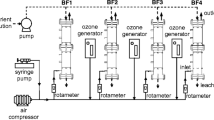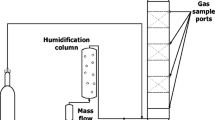Abstract
Excessive growth of biomass and retention of solids associated with air bubbles lead to bed clogging, which affects the biofilters’ performance. Two experiments were carried out in a submerged biofilter at the flow velocity of 0.5 m h−1, for an organic loading rate of 51 g C m−3 h−1 and a nitrogen loading rate of 13 g NH4-N m−3 h−1, one with the biofilter not aerated, the other with the biofilter partially aerated. The results showed that the higher head losses occurred in the upper section of the biofilter, where there was a greater biomass development and a higher removal of organic carbon, ammonia and solids, with the maximum allowed head loss being reached in 16 and 8 days. In any case, the steady-state conditions were achieved after 2 days and were interrupted on the tenth day of experiment E1 and on the fifth day of experiment E2. This allowed defining different operating cycles that enabled an average organic removal rate of 12.7 g C m−3 h−1 (27 %) and an average ammonia removal rate of 1.1 g NH4-N m−3 h−1 (9 %) without aeration, and of 35.8 g C m−3 h−1 (76 %) and 6.3 g NH4-N m−3 h−1 (51 %) with aeration. Regardless of the aeration conditions, more than 90 % of TOC and NH4-N removal occurred in the upper section. After the backwashing cycle, the biofilter returned to steady-state conditions in 6 h (without aeration) and 7 h (with aeration).








Similar content being viewed by others
References
Albuquerque A, Makinia J, Pagilla K (2009a) Investigation of nitrogen removal pathways in a biological packed bed reactor using elementary mass balances. In: WEF 2nd specialty conference on nutrient removal 2009: sustainable treatment solutions. Washington, USA 28 June–1 July. WEF, Alexandria, USA, pp 117–135
Albuquerque A, Oliveira J, Semitela S, Amaral L (2009b) Influence of bed media characteristics on ammonia and nitrate removal in shallow horizontal subsurface flow constructed wetlands. Bioresour Technol 100:6269–6277
Albuquerque A, Makinia J, Pagilla K (2011) Influence of aeration on nitrogen removal in a submerged biological aerated filter for residuals removal. In: WEF nutrient recovery and management 2011 conference. Miami, USA 9–12 January. WEF, Alexandria, USA, pp 931–944
APHA-AWWA-WEF (1999) Standard methods for the examination of water and wastewater, 20th edn. American Public Health Association, Washington DC, USA
Behera S, Rene E, Murthy D (2007) Performance of up-flow anoxic bioreactor for wastewater treatment. Int J Environ Sci Technol 4(2):247–252
Buitrón G, Quezada M, Moreno G (2004) Aerobic degradation of the azo dye acid red 151 in a sequencing batch biofilter. Bioresour Technol 92(2):143–149
Chang Y, Henkel J, Meda A, Wagner M, Cornel P (2008) Greywater treatment for intra-urban water reuse—comparison of different treatment techniques. In: IWA conference on sanitation options in the Asia-Pacific. Hanoi, Vietnam, 18–20 November, IWA, London, UK
Coetzee M, Van der Merwe M, Badenhorst J (2011) The effect of nitrogen loading rates on nitrogen removal by using a biological filter proposed for ventilated improved pit latrines. Int J Environ Sci Technol 8(2):363–372
Colt J, Lamoureux J, Pattersonc R, Rogers G (2005) Reporting standards for biofilter performance studies. Aquac Eng 34(3):377–388
Dang J, Harvey D, Lobbary A, Grady C Jr (1989) Evaluation of biodegradation kinetic with respirometric data. Res. J Water Pollut Control Fed 61(11/12):1711–1721
Di Iaconi C, Ramadori R, Lopez A (2005) Aerobic granulation during the start up period of a periodic biofilter. In: Bath SE, De Kreuk MK (eds) Aerobic granular sludge. Water Environ Manag Ser, London, pp 25–34
Farabegoli G, Chiavola A, Rolle E (2009) The biological aerated filter (BAF) as alternative treatment for domestic sewage. Optimization of plant performance. J Hazard Mater 171(1-3):1126–1132
Garzon-Zuniga M, Lessard P, Aubry G, Buelna G (2005) Nitrogen elimination mechanisms in an organic media aerated biofilter treating pig manure. Environ Technol 26:361–371
Gonçalves F, Oliveira F (1996) Improving the effluent quality of facultative stabilization ponds by means of submerged aerated biofilters. Water Sci Technol 33(3):145–152
Grady C Jr, Daigger G, Lim H (1999) Biological wastewater treatment, 2nd edn. Marcel Dekker, New York, p 1076
Ha J, Ong S (2007) Nitrification and denitrification in partially aerated biological aerated filter (BAF) with dual size sand media. Water Sci Technol 55(1–2):9–17
Ha J, Ong S, Surampallic R, Song J (2010a) Temperature effects on nitrification in polishing biological aerated filters (BAFs). Environ Technol 31(6):671–680
Ha J, Ong S, Surampalli R (2010b) Impact of media type and various operating parameters on nitrification in polishing biological aerated filters. Environ Eng Res 15(2):79–84
He S, Xue G, Kong H (2007) The performance of BAF using natural zeolite as filter media under conditions of low temperature and ammonium shock load. J Hazard Mater 143:291–295
Hidaka T, Tsuno H (2004) Development of a biological filtration model applied for advanced treatment of sewage. Water Res 38:335–346
ISO 9408 (1999) Qualité de l’eau—Évaluation, en milieu aqueux, de la biodégradabilité aérobie ultime des composés organiques par détermination de la demande en oxygène dans un respiromètre fermé. ICS: 13.060.70, International Standardisation Association
Lei G, Qi B, Wang Z, Wang J (2009) Treatment of municipal sewage by biological aerated filter (BAF) using burned clay pellet as media. Int J Environ Pollut 37(2–3):186–204
Liu F, Zhao C, Zhao D, Liu GH (2008) Tertiary treatment of textile wastewater with combined material biological aerated filter (CMBAF) at different hydraulic loadings and dissolved oxygen concentrations. J Hazard Mater 160:161–167
Liu B, Yan D, Wang Q, Li S, Yang S, Wu W (2009) Feasibility of a two-stage biological aerated filter for depth processing of electroplating-wastewater. Bioresour Technol 100:3891–3896
Liu Y, Yang T, Yuan D, Wu X (2010) Study of municipal wastewater treatment with oyster shell as biological aerated filter medium. Desalination 254:149–153
Mendoza-Espinosa L, Stephenson T (1999) A review of biological aerated filters for wastewater treatment. Environ Eng Sci 16:201–216
Osorio F, Hontoria E (2001) Optimization of bed material height in a submerged biological aerated filter. J Environ Eng 127(11):974–978
Osorio F, Torres J, Hontoria E (2006) Study of biological aerated filters for the treatment of effluents from the citrus industry. J Environ Sci Health Part A 41(12):2683–2697
Ozis F, Bina A, Devinny S (2007) Biofilm growth-percolation models and channeling in biofilter clogging. J Air Waste Manag Assoc 57(8):882–892
Rabinovich S (2005) Measurement errors and uncertainties: theory and practice, 3rd edn. Springer, New York 308
Rajakumar R, Meenambal T, Rajesh Banu J, Yeom I (2011) Treatment of poultry slaughterhouse wastewater in upflow anaerobic filter under low upflow velocity. Int J Environ Sci Technol 8(1):149–158
Robinson A, Brignal W, Smith AJ (1994) Construction and operation of a submerged aerated filter sewage-treatment works. Water Environ J 8(2):215–227
Schulz J, Menningmann G (2008). Submerged fixed-bed reactors. In: Rehm H, Reed G (eds) Biotechnology: environmental processes I. Vol 11a, 2nd edn. Wiley, Weinheim
Soewondo P, Yulianto A (2008) The effect of aeration mode on submerged aerobic bio filter reactor for grey water treatment. J Appl Sci Environ Sanit 3(3):169–175
Stephenson T, Pollard S, Cartmell E (2003) Feasibility of biological aerated filters (BAF) for leachate treatment. In: 9th international waste management and landfill symposium. S. Margherita di Pula, Cagliari, Italy, 6–10 October, CISA, Italy
Taghizadeh M, Torabian A, Borghei M, Hassani A (2007) Feasibility study of water purification using vertical porous concrete filter. Int J Environ Sci Technol 4(4):505–512
Tchobanoglous G, Burton F, Stensel H (2002) Wastewater engineering. Treatment and reuse, 4th edn. McGraw-Hill, New York
Villaverde S, Fdz-Polanco F, Garcia J (2000) Nitrifying biofilm acclimation to free ammonia in submerged biofilters: startup influence. Water Res 34(2):602–610
Visvanathan C, Nhien T (1995) Study on aerated biofilter process under high temperature conditions. Environ Technol 16(4):301–314
Xie W, Wang Q, Song G, Kondo M, Teraoka M, Ohsumi Y, Hiroaki I (2004) Upflow biological filtration with floating filter media. Proc Biochem 39(6):767–772
Yang J, Liu W, Li B, Yuan H, Tong M, Gao J (2010) Application of a novel backwashing process in upflow biological aerated filter. J Environ Sci 22(3):362–366
Acknowledgments
The authors also wish to extend their sincere gratitude to all who assisted in promoting the present work.
Author information
Authors and Affiliations
Corresponding author
Rights and permissions
About this article
Cite this article
Albuquerque, A., González-Martínez, A. & Osorio, F. Effect of aeration on steady-state conditions in non- and partially aerated low-loaded biofilter. Int. J. Environ. Sci. Technol. 9, 395–408 (2012). https://doi.org/10.1007/s13762-012-0073-3
Received:
Revised:
Accepted:
Published:
Issue Date:
DOI: https://doi.org/10.1007/s13762-012-0073-3




